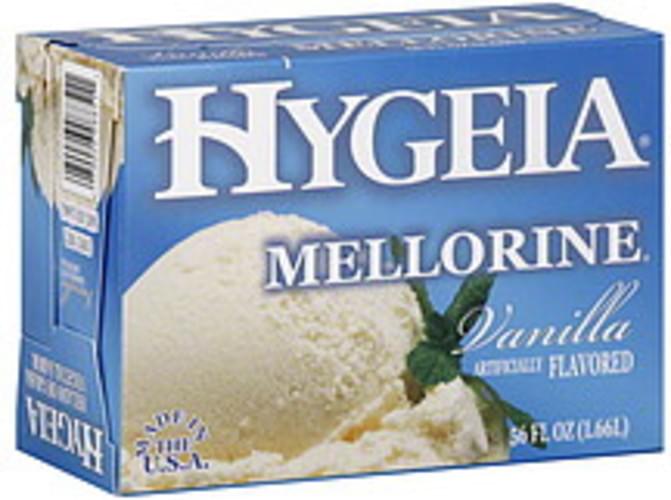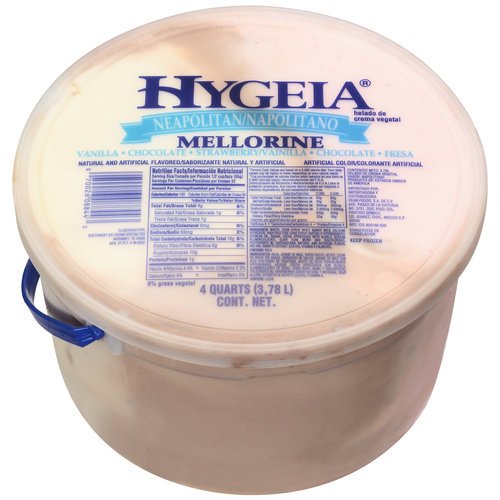Ever stumbled upon a frozen treat that tasted familiar yet strangely different? It might just have been mellorine, a fascinating and often misunderstood dessert that challenges our very definition of ice cream.
Mellorine, in essence, occupies a unique space in the frozen dessert landscape. It's produced using a similar process to ice cream, the defining characteristic lies in its fat composition. Instead of relying solely on butterfat, mellorine incorporates highly refined vegetable oils, such as soybean or palm oil. This substitution results in a product that often boasts a lower price point than traditional ice cream, making it an attractive alternative for budget-conscious consumers and large-scale institutions. The flavor profile, while aiming to mimic the creamy richness of ice cream, often leans towards a lighter, less intensely fatty experience. Some describe it as closer to a custard, sherbet, or even frozen yogurt in texture and taste, depending on the specific formulation and the skill of the maker. The experience can be subjective. Imagine the relationship between butter and margarine; thats a very relatable comparison to consider.
| Category | Information |
|---|---|
| Definition | A frozen dessert similar to ice cream but with vegetable oil or other non-dairy fat substituted for butterfat. |
| Composition | Must contain pasteurized milk but the fat content comes from vegetable oils or other non-dairy fats. May include milk solids, sweeteners, stabilizers, and flavorings. |
| Production | Produced in the same way as ice cream, involving mixing ingredients, pasteurizing, homogenizing, freezing, and hardening. |
| Taste and Texture | Often described as having a lighter, less rich flavor than ice cream. The texture can vary but is generally smooth and creamy. |
| Availability | Less common than ice cream, often found in institutional settings or as a budget-friendly alternative. Selecta sells their ice cream as mellorine in North America. |
| Historical Context | Emerged as an ice cream alternative due to economic factors and the availability of vegetable oils. |
| US Regulations | Defined in the Code of Federal Regulations, Title 21 Food and Drugs, Part 135 Frozen Desserts, specifying compositional standards. |
| Fat Content | Has a lower butterfat content compared to traditional ice cream. |
| Ingredients | Can be made from both animal fat and vegetable fat. |
| Related Products | Similar to ice cream, ice milk, and frozen custard, differing primarily in fat content and source. |
| Soft Serve | Can be used as a base for soft serve, which is stirred while being frozen and has air whipped into it. |
| Goat's Milk Version | "Goat's milk ice cream or alternatively, ice cream made with goat's milk", if egg yolk solids are high it is named as goat's milk frozen custard or, alternatively, frozen custard made" |
| Reference | US Code of Federal Regulations, Title 21, Part 135 |
The story of mellorine is interwoven with economic shifts and evolving consumer preferences. During periods of butterfat shortages or price fluctuations, manufacturers sought alternative ingredients to maintain affordability and production volume. Vegetable oils presented a viable solution, leading to the creation and widespread adoption of mellorine. While it might not always be prominently displayed in supermarkets today, its legacy endures in school cafeterias, hospitals, and other institutional settings where cost-effectiveness remains a primary concern. It's the unsung hero of the frozen dessert world, quietly satisfying cravings without breaking the bank.
- Pearl Carter From Youngest Pilot To Backstreet Baby Names
- The Diplomat Ronnies Fate Season 2 Twists Explained
Finding mellorine in the 21st century can be something of a treasure hunt. It rarely occupies prime real estate in mainstream grocery stores, often relegated to the back freezer or absent altogether. However, with a bit of diligence, you can still unearth this elusive treat. Start by exploring local discount grocery chains or stores that cater to institutional clients. Online retailers specializing in bulk food supplies may also offer mellorine options. Don't overlook specialty ice cream shops or creameries, as some may experiment with mellorine formulations to offer unique flavor profiles or cater to specific dietary needs. The quest for mellorine can become an adventure in itself, leading you to unexpected corners of the culinary landscape.
To truly appreciate mellorine, one must delve into its historical and cultural context. It emerged as a pragmatic response to economic constraints, offering a more accessible alternative to traditional ice cream. In some regions, mellorine became deeply ingrained in local food culture, evoking nostalgic memories of childhood treats and community gatherings. Understanding its origins sheds light on its enduring appeal, even in an era of artisanal ice cream and gourmet frozen desserts. Mellorine represents a piece of culinary history, a reminder that innovation often arises from necessity.
The taste and texture of mellorine are subjective and can vary depending on the specific recipe and ingredients used. Generally, it offers a lighter, less intensely creamy experience than ice cream. The vegetable oils contribute a subtle flavor that may be perceived as neutral or slightly different from butterfat. Some find it refreshing and less heavy, while others miss the rich, decadent mouthfeel of traditional ice cream. The texture can range from smooth and velvety to slightly icy, depending on the freezing process and the addition of stabilizers. Ultimately, the enjoyment of mellorine comes down to personal preference and an appreciation for its unique qualities.
Consider the versatility of mellorine. Because of its lower fat content and often neutral flavor profile, it can serve as an excellent base for creative culinary experimentation. Chefs and home cooks alike can use it to create innovative frozen desserts with unique flavor combinations and textures. Imagine a mellorine infused with exotic spices, tropical fruits, or even savory herbs. The possibilities are endless. Mellorine also lends itself well to vegan or dairy-free adaptations, as the vegetable oil base can be easily combined with plant-based milk alternatives and flavorings. It's a blank canvas for frozen dessert artistry.
The rise of artisanal ice cream and gourmet frozen desserts has undoubtedly overshadowed mellorine in recent years. Consumers are increasingly seeking premium ingredients, unique flavor profiles, and handcrafted products. However, mellorine retains a certain charm and relevance, particularly for those seeking a budget-friendly or nostalgic treat. It reminds us that not all desserts need to be extravagant or indulgent to be enjoyable. Sometimes, simplicity and affordability are the most appealing qualities. Mellorine is a testament to the enduring power of a humble, yet satisfying, frozen dessert.
While reduced-fat ice cream aims to lower fat content compared to traditional ice cream, mellorine distinguishes itself through the source of that fat. Reduced-fat ice cream often still relies on dairy fat, albeit in smaller quantities, while mellorine substitutes it entirely with vegetable oils. This difference can be significant for individuals with dietary restrictions or preferences. Someone avoiding dairy might find mellorine a suitable alternative, whereas reduced-fat ice cream may still pose a problem.
The amount of air incorporated into a frozen dessert significantly impacts its texture and perceived quality. Soft serve, whether it's made from ice cream, ice milk, or mellorine, relies on the introduction of air during the freezing process. This aeration creates a light, fluffy texture that is characteristic of soft serve. However, too much air can result in a product that melts quickly and lacks substance. The ideal amount of air varies depending on the recipe and the desired consistency, but a balance must be struck to achieve a satisfying soft serve experience.
The U.S. compositional standards, outlined in the Code of Federal Regulations (CFR), define the specific requirements for various frozen desserts, including ice cream, frozen custard, mellorine, sherbet, and water ices. These standards dictate the minimum percentage of milkfat, the permissible ingredients, and the labeling requirements for each type of product. Understanding these regulations is crucial for manufacturers to ensure compliance and for consumers to make informed choices about the frozen desserts they consume.
Selecta, a well-known ice cream brand, markets some of its products as mellorine or "frozen dessert" in North America. This highlights the versatility of mellorine and its ability to cater to different consumer preferences and regional regulations. By offering both traditional ice cream and mellorine options, Selecta appeals to a wider range of customers and demonstrates the enduring appeal of this often-overlooked frozen treat.
Even the world of non-dairy frozen desserts has been impacted by the principles behind mellorine. Kurz, known for his work in frozen desserts, explored using nuts as the fat source for a sorbet to achieve an ice cream-like density. This innovative approach mirrors the core concept of mellorine: substituting traditional fat sources with alternatives to achieve a desired texture and flavor profile. Whether it's vegetable oils or nut fats, the spirit of experimentation and adaptation remains central to the evolution of frozen desserts.
And for those seeking even more specialized options, consider goat's milk ice cream. This niche product, regulated under specific guidelines, further expands the landscape of frozen dessert possibilities. If the egg yolk solids content exceeds the standard for goat's milk ice cream, it's then classified as "goat's milk frozen custard." These subtle distinctions underscore the importance of precise ingredient ratios and adherence to regulatory standards in the realm of frozen desserts.
So, the next time you encounter a frozen treat that deviates slightly from the familiar taste of ice cream, remember mellorine. It's a reminder that innovation, affordability, and regional preferences play a significant role in shaping our culinary experiences. It's a humble dessert with a rich history, waiting to be rediscovered and appreciated for its unique qualities. Dont dismiss it outright; give it a try. You might be surprised at how much you enjoy this classic alternative.
- Charlotte Flair Espn Body Issue Leaked Photo Controversy
- Keanu Reeves Sisters Kim Karina Emma Untold Stories


